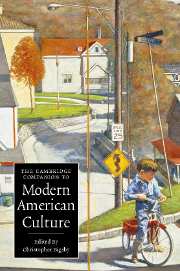Book contents
- Frontmatter
- 1 Introduction: What, then, is the American?
- 2 The American century
- 3 The regions and regionalism
- 4 Immigration to the United States in the twentieth century
- 5 Religion in the United States in the twentieth century: 1900-1960
- 6 Shifting boundaries: religion and the United States: 1960 to the present
- 7 The Hispanic background of the United States
- 8 African Americans since 1900
- 9 Asian Americans
- 10 Women in the twentieth century
- 11 Queer America
- 12 The United States, war, and the twentieth century
- 13 The culture of the Cold War
- 14 Secret America: the CIA and American culture
- 15 Vietnam and the 1960s
- 16 New York City and the struggle of the modern
- 17 Music: sound: technology
- 18 African American music of the twentieth century
- 19 Hollywood cinema
- 20 Popular culture
- 21 Theatre
- 22 Society and the novel in twentieth-century America
- 23 “Preferring the wrong way”: mapping the ethical diversity of US twentieth-century poetry
- Index
- Series List
3 - The regions and regionalism
Published online by Cambridge University Press: 28 January 2007
- Frontmatter
- 1 Introduction: What, then, is the American?
- 2 The American century
- 3 The regions and regionalism
- 4 Immigration to the United States in the twentieth century
- 5 Religion in the United States in the twentieth century: 1900-1960
- 6 Shifting boundaries: religion and the United States: 1960 to the present
- 7 The Hispanic background of the United States
- 8 African Americans since 1900
- 9 Asian Americans
- 10 Women in the twentieth century
- 11 Queer America
- 12 The United States, war, and the twentieth century
- 13 The culture of the Cold War
- 14 Secret America: the CIA and American culture
- 15 Vietnam and the 1960s
- 16 New York City and the struggle of the modern
- 17 Music: sound: technology
- 18 African American music of the twentieth century
- 19 Hollywood cinema
- 20 Popular culture
- 21 Theatre
- 22 Society and the novel in twentieth-century America
- 23 “Preferring the wrong way”: mapping the ethical diversity of US twentieth-century poetry
- Index
- Series List
Summary
US history has been profoundly shaped by the existence of regions and regional consciousness, though the terms “sections” and “sectionalism” were more commonly used until the late nineteenth century. In its formative moments - the Continental Congress and the Constitutional Convention - the new republic was already divided along sectional lines that in turn marked out different economic, social, political, and security interests. Indeed, two of the defining “facts” about the United States of America - the existence of slavery and the presence of (so-called) “free land” in the West - made sectional politics inevitable. From them emerged the North-South and the East-West polarities in American politics and culture. Moreover, the three-sided contest among the Northeast, the South, and the West was one of the preconditions for the American Civil War (1861-5), with the South squared off against the North for control of the trans-Mississippi West. Without slavery there would have been no war, but had the peculiar institution been scattered evenly across the continent, it is hard to imagine that there could have been a sectional crisis.
- Type
- Chapter
- Information
- The Cambridge Companion to Modern American Culture , pp. 53 - 72Publisher: Cambridge University PressPrint publication year: 2006



